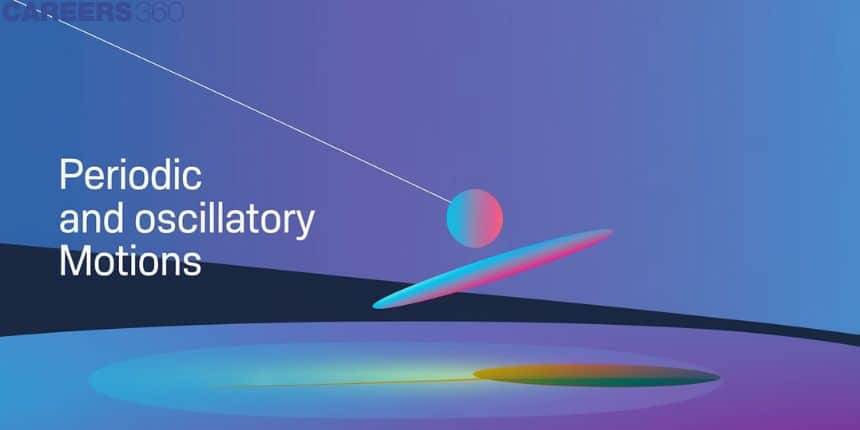Periodic And Oscillatory Motions
Periodic motion is any recurring movement after short periods of time such as swinging a pendulum or rotating the Earth; the oscillation of a spring is another example. It is also known as oscillatory motion and is characterized by a to and fro movement about an equilibrium point.
In this article, the definitions, equations and real-world examples of periodic and oscillatory motions will be explained. This write-up will also articulate their importance in IIT-JEE and NEET explaining how one can master them. Having gone through it, the reader is expected to possess a good grounding that enables them to solve the related problems successfully during their exams. In the last ten years of JEE Main, no direct question was asked but in NEET one question has been asked.
- What is Periodic Motion?
- What is Oscillatory Motion?
- Solved Examples Based on Periodic and Oscillatory Motions
- Summary

What is Periodic Motion?
A motion, which repeats itself over and over again after a regular interval of time is called a periodic motion. The fixed interval of time after which the motion is repeated is called time period of the motion.
If a particle moves along the x-axis, its position depends upon time t. We express this fact mathematically by writing x=f(t) or x(t) There are certain motions that are repeated at equal intervals of time. By this, we mean that the particle is found at the same position moving in the same direction with the same velocity and acceleration, after each period of time. Let T be the interval of time in which motion is repeated. Then x(t)=x(t+T)
where T is the minimum change in time. And the function that repeats itself is known as a periodic function.
Examples :
Revolution of the earth around the sun (period one year)
Rotation of earth about its polar axis (period one day)
Motion of hour’s hand of a clock (period 12-hour)

Fig:- Examples of Periodic motion
What is Oscillatory Motion?
Oscillatory motion is that motion in which a body moves to and fro or back and forth repeatedly about a fixed point in a definite interval of time.



Every oscillatory motion is periodic if energy is not lost anywhere, but every periodic motion need not be oscillatory. Circular motion is a periodic motion, but it is not oscillatory.
General Equation of Oscillatory Motion
When a body is given a small displacement from the equilibrium position, a force starts acting towards the equilibrium position (or mean position) which tries to bring the body back to its mean position. And that force is given by:-
F=−kxn, where x is measured from the mean position and n=1,3,5,7,9 etc
When x = positive, F = negative
When x = negative, F = positive
When x= 0, F=0,i.e., at mean position

Recommended Topic Video
Solved Examples Based on Periodic and Oscillatory Motions
Example 1: A particle is moving in a circle with uniform speed. Then its motion is:
1) Periodic
2) Non-Periodic
3) Can't say
4) linear
Solution:
Periodic Motion
A motion of an object that regularly returns to a given position after a fixed time interval.
e.g. earth returns to the same position in its orbit around the sun each year.
Circular motion with uniform speed is an example of periodic motion
Hence, the answer is the option (1).
Example 2: Acceleration of particle, executing SHM, at its mean position is
1) Infinity
2) varies
3) Maximum
4) zero
Solution:
Mean Position
A position during oscillation where the particle is at the equilibrium position, i.e. net force on the particle at this position is zero.
wherein
Force acting on particles always points towards the mean position.
a=−ω2y[ at mean y=0]
So acceleration = 0.
Hence, the answer is the option (4).
Example 3: What is the time period of the Sine Function
1) π
2) 2π
3) π2
4) 1
Solution:
As the graph of sine function is given as

And this function is repeating itself after a time interval of 2π
Hence, the answer is option (2).
Example 4: Which of the following equations does not represent a simple harmonic motion?
1) y=asinwt
2) y=acoswt
3) y=asinwt+bcoswt
4) y=atanwt
Solution:
For an equation to represent SHM, it must satisfy d2ydt2=−ω2y, and it is not satisfied by y=atanωt
Hence, the answer is the option (4).
Example 5: The displacement of a particle along the x-axis is given by x=asin2wt. The motion of the particle corresponds to-
1) Simple harmonic motion of frequency ω2π
2) Simple harmonic motion of frequency ωπ
(3) Simple harmonic motion of frequency 3ω2π
4) No simple harmonic motion
Solution:
For the body to perform SHM it should follow acceleration = a′=−w2x
In the question
x=asin2wt=a2(1−cos2ωt)dxdt=a22ωsin2wtd2xdt=4ω2a2cos2ut
This does not satisfy acceleration= a′=−w2x
This does not represent an S.H.M.
Hence, the answer is the option (4).
Summary
A repeating motion is referred to as periodic motion. One particular kind of periodic motion is referred to as "simple harmonic motion." One particularly helpful kind of periodic motion is simple harmonic motion (SHM). Our SHM prototype is a mass connected to a spring. The amplitude is the largest displacement from its equilibrium position that the mass undergoes. It travels a greater distance on one side than on the other(the other side). For one successful complete back-and-forth movement, the period of motion is the time required. It is most often measured in seconds.
Frequently Asked Questions (FAQs)
Also Read
02 Jul'25 06:18 PM
02 Jul'25 05:34 PM
02 Jul'25 05:33 PM
02 Jul'25 05:00 PM
02 Jul'25 04:50 PM
02 Jul'25 04:49 PM
02 Jul'25 04:35 PM
02 Jul'25 04:33 PM
02 Jul'25 04:32 PM
